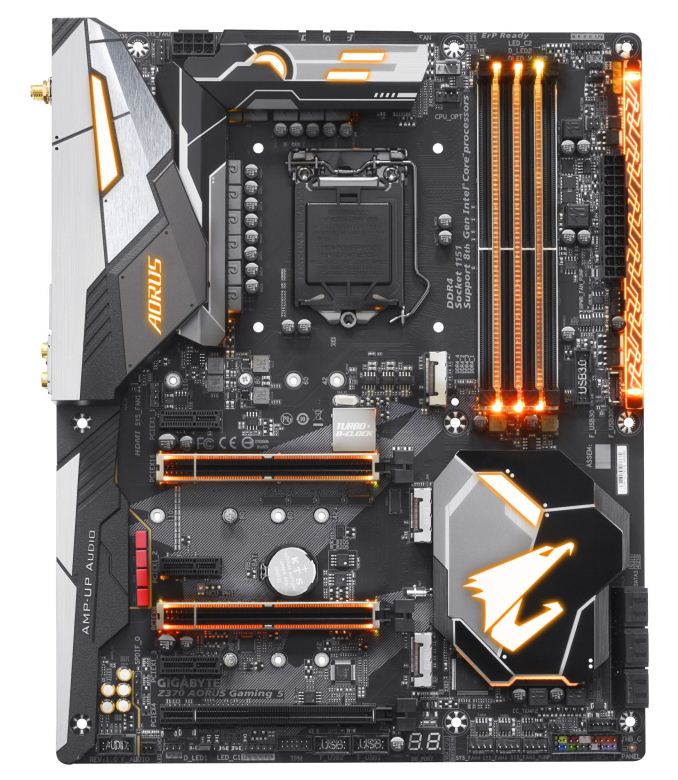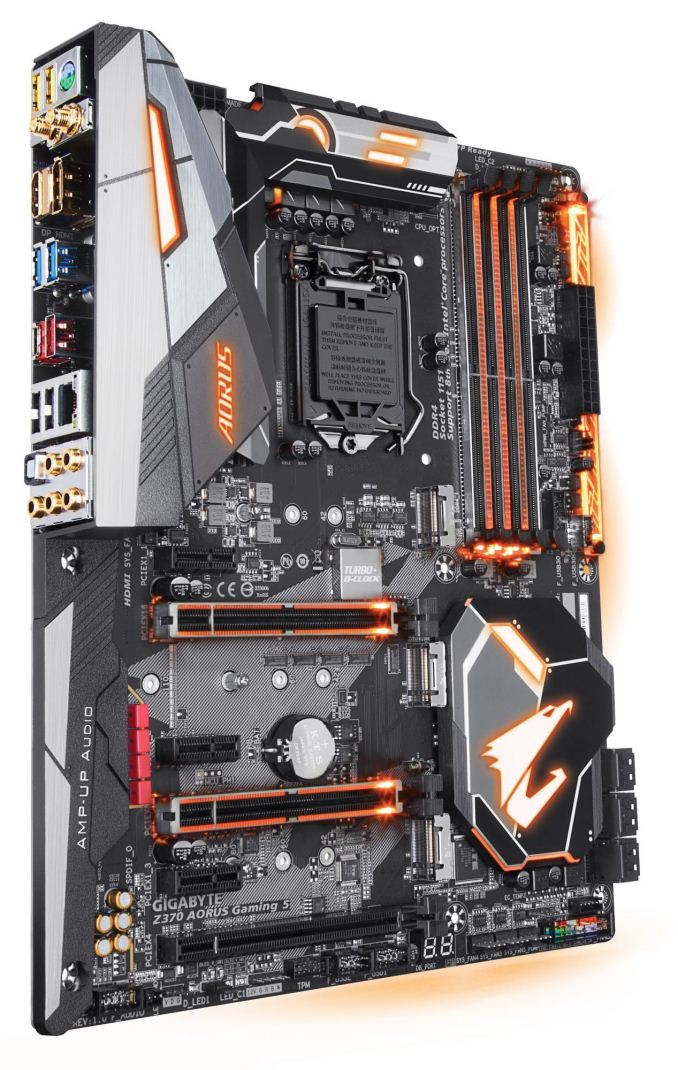Analyzing Z370 for Intel's 8th Generation Coffee Lake: A Quick Look at 50+ Motherboards
by Ian Cutress, Anton Shilov, Joe Shields & Gavin Bonshor on October 20, 2017 2:00 PM ESTGIGABYTE Z370 Gaming 5
The next board from GIGABYTE is the Z370 AORUS Gaming 5. The Gaming 5 sits just below the Gaming 7 in the product stack with a few different features as well as some aesthetic changes. A cursory look at the board and for the most part it looks like the Gaming 7 but with a reduction in some of the features.
The Gaming 5 keeps the black PCB and the AORUS falcon stenciled across the bottom but the stencil appears to be shifted a bit lower on the board, ending at the top PCIe x1 slot. RGB LEDs populate the same locations as on the Ultra Gaming and add more to the I/O shroud and the VRM heatsink. Both the VRM heatsink and shroud have silver colored design elements and a slightly different shape to some of the other GIGABYTE models. The PCH heatsink has an angular aesthetic as well as additional RGB LEDs. The Gaming 5 also has two RGB LED headers (both RGBW headers) all controlled by the RGB Fusion Software.
The board has four reinforced memory slots supporting dual-channel DDR4 with capacity up to 64GB and speeds of DDR4-4133+. For the PCIe slots, there are two full-length reinforced slots at x16 and x8 from the CPU, and the third, non-reinforced full-length x4 slot at the bottom from the chipset. The PCIe x1 slots are also in the same locations as the Gaming 7, one above each of the full-length PCIe slots.
SATA for the Gaming 5 involves six ports supporting RAID 0, 1, 5, and 10. The Gaming 5 places all six together and oriented the same way on the board. The board has three M.2 slots (1x 110mm, 2x 80mm), however, none have a heatsink as the flagship Gaming 7 did. For fan connectivity, there are a total of six on the board; two up top by the CPU, three on the bottom, and another just above the top PCIe x1 slot. The audio codec is the same Realtek ALC1220 as the Gaming 7, but we are unable to tell if it has EMI shielded from the images. There is still a single Intel I219-V NIC, but the Gaming 5 adds integrated WiFi and Bluetooth capabilities. The 5-pin Thunderbolt 3 header moves down to the bottom right-hand corner of the board, just above the front panel headers.
USB 3.1 (10 Gbps) support is handled by the ASMedia 3142 controller and provides a Type-C port and Type-A port on the back panel IO. The chipset provides an additional six USB 3.1 (5 Gbps) ports with four on the back panel and two more available through an internal USB header. There is also USB 2.0 support with two ports on the back panel and four through internal headers. The back panel IO has DisplayPort and HDMI outputs for onboard video, the Wi-Fi adapter, NIC, and gold plated audio with SPDIF.















83 Comments
View All Comments
weevilone - Wednesday, October 25, 2017 - link
Notable that though the new boards are often very similar to their Z270 predecessors, Asus has dropped Thunderbolt 3 support from the Maximus X Hero board.masouth - Thursday, October 26, 2017 - link
ASUS ROG Z370 Maximus X Hero"....new metallic heat sinks that are an upgrade over the plastic heatsinks found on the Z270 version"
Please excuse my ignorance because I didn't own a ROG Z270 mb but...plastic HEAT SINKS? Not shrouds or decoration over a heat sink but the actual heat sinks themselves? That's either wrong, they performed their job pretty poorly, or plastic resins have advanced a lot farther in thermal conductivity (and cost for such) than I realized.
flowrush - Sunday, November 19, 2017 - link
"The other main distinguishable feature is the inclusion of integrated 802.11ac Wi-Fi with an antenna (that can only be described as a shark fin) found on the F."The above is incorrect in the article. The integrated Wi-Fi module with antenna is found on the E not the F.
Coldgame - Saturday, November 25, 2017 - link
I'm looking to build a rig with the Z370 Gaming ITX/ac, a GTX-1070 card and an Apple Thunderbolt Display.The review states:
"The key difference in the support between the two boards is going to be the Thunderbolt 3 port on the Gaming-ITX. This port supports video outputs..."
So, can anyone confirm or deny that video generated by the GTX-1070 can be output through the onboard Thunderbolt 3 port?
hanselltc - Sunday, December 3, 2017 - link
Looking forward to low-middle end mITX choices from this platform. It'll probably be paired with a 8100/8300 and be my secondary machine.Roen - Sunday, February 4, 2018 - link
Where are the 10 Gbps ports on the back? They all look like 5 Gbps ports, even the Type C.rbarak - Wednesday, February 21, 2018 - link
Is anyone using the Z370-P on Linux with two screens?I built a new machine based on the Z370-P, and both the DVI and the HDMI connected screens show the same image, and the RHEL7 setup/displays show only one Unknown Display.
I follwed the advice on stackexchange, and added this line:
$ grep GRUB_CMDLINE_LINE_DEFAULT /etc/default/grub
GRUB_CMDLINE_LINE_DEFAULT="i915.alpha_support=1"
Then I did:
sudo grub2-mkconfig -o "$(readlink /etc/grub2.conf)"
And rebooted, but still, the two displays are not shown.
dromoxen - Wednesday, May 9, 2018 - link
Shocked to see that both the Asrock mitx boards are "szie=ATX" .. LOLThe addition of Tunderbolt sure seems to add a hefty premium £120 vs £160 , luckily I can do without.
Kroebo - Sunday, October 7, 2018 - link
Sadly, I discovered that the ZUG Gaming PLUS doesn't support SLI.trag - Tuesday, January 15, 2019 - link
On the ASrock Z370M Pro4 the M.2 slot information is backwards. Both slots support NVME. One slot also supports SATA. As written, "The first M.2 slot is SATA only while the second supports PCIe." it seems to say that one slot is SATA only and the other slot is PCIe (NVME) only.